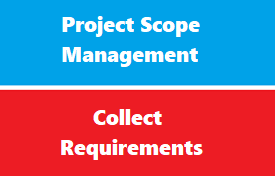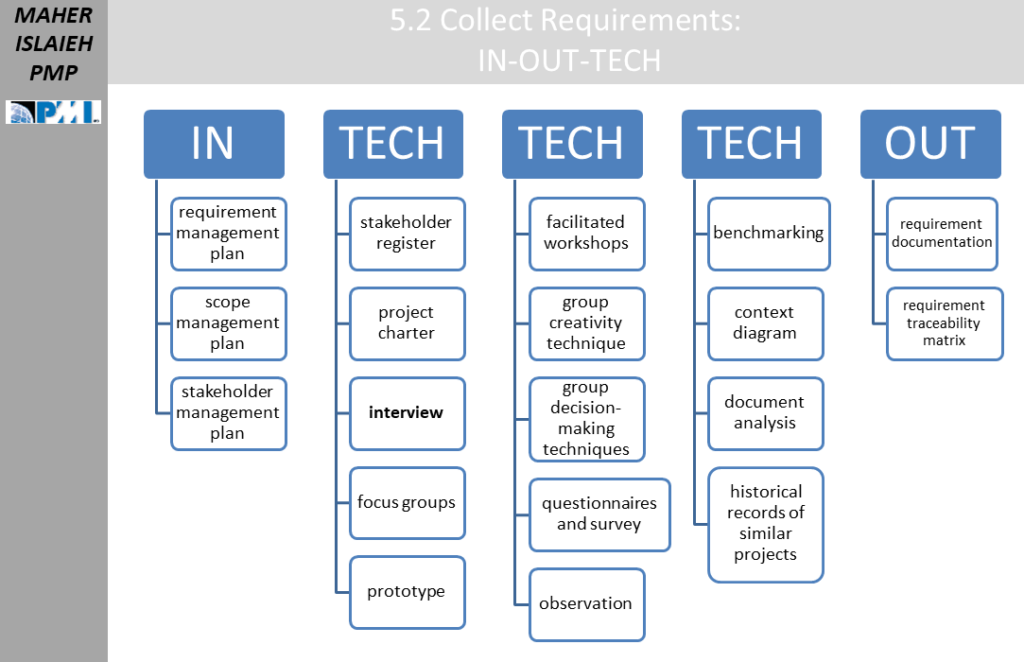introduction
the second process of scope management area after plan scope management is to collect requirements
let us to discuss it below :
what is requirements
requirements are “what stakeholders expect from a project, or from the product of the project”.
Requirements of the stakeholders must be gathered in the project and managed properly.
After requirements are finalized, these must be included in the scope and tracked throughout the project.
Also, how requirements are met with the project deliverables must be demonstrated to the project stakeholders to complete a project successfully.
collect requirements process
Collect requirements process is the second process of scope management knowledge area. In order to define the scope,
The main purpose of the collect requirements process is gathering stakeholder requirements in a project.
the requirements of the stakeholders must be collected at first stages
This process will give you a clear idea of what your stakeholders want and how you’re going to manage their expectations.
You will document exactly what is wanted out of the project as far as status updates and final deliverables.
This information can be gathered through focus groups, interviews, or surveys, and by creating prototypes.
Your requirements management plan can help you avoid many frustrating hurdles throughout the project.
collect requirements inputs-outputs-techniques
Inputs
- requirement management plan
- scope management plan
- stakeholder management plan
Techniques
- stakeholder register
- project charter
- interview
- focus groups
- prototype
- facilitated workshops
- group creativity technique
- group decision-making techniques
- questionnaires and survey
- observation
- benchmarking
- context diagram
- document analysis
- historical records of similar projects
Outputs
- requirement documentation
- requirement traceability matrix
Technique : Interviewing
Interviewing is the first collect requirements technique.
It can be done:
- through meeting,
- through a phone call
- or through e-mails.
- Or through conference specially these days with COVID19 🙂
In this collect requirements technique Project Manager interviews the stakeholders to get their requirements.
There can be a checklist, a list of questions or project manager can just ask the stakeholders to express their expectations from the project in a free form.
Project manager notes down and stores the requirements received from the project stakeholders.
Technique : Groups
Type of Groups
Focus Group:
bring prequalified stakeholder with expert to learn about expected specifications and attitude of proposed product
Facilitated Group :
bring key stakeholder together to define product requirements and build good relation sample of facilitated workshops is joint application development JAD in software project and quality function deployment QFD in industry project
Group Creativity Technique :
sample of group creativity techniques :
- brainstorming session: just bring ideas to other techniques to be voted
- nominal session voting of brainstorming ideas
- idea mind technique
- affinity diagram : classify many ideas to analyzed
- multi-criteria decision analysis: ranking ideas and prioritize it
technique : Group Decision Making
technique : Group Decision Making
In this collect requirements process technique, several opinions are evaluated in a group.
There can be several requirements about a project and each stakeholder might express their own requirements. In the end, these must be evaluated whether these requirements will be in the project scope.
There are four approaches in Group Decision Making technique:
- Unanimity: In this case, everyone agrees with the idea that is being evaluated. So it is qualified to be in the final list.
- Majority: In this case, more than 50% of the group agrees on a requirement. In order to put a requirement on the final scope, if this approach is applied, more than half of the group must agree on it.
- Plurality: In this case, largest block in a group agrees on a requirement. For instance, if 40% of the group agrees, 30% of the group disagrees and 30% of the group does not have a decision since the largest part of the group agrees, the requirement will be qualified to be in the scope.
- Dictatorship: In this approach, one individual makes the decision for the group on a requirement. For instance, if the Senior Director is in the group and if he has the privilege to approve or disapprove a requirement, regardless of what other participants think, Senior Director’s decision will determine whether the requirement will be in the project scope.
Technique : Benchmarking
Benchmarking :
- compare actual or planed practices (operation), to comparable organization (competitors) to generate new ideas
Resolving Competing Requirements :
- project manager should accept requirements that comply with :
- business case
- project charter
- scope statement if available when conflict occur
- constraints
Technique Brainstorming
Fourth collect requirements process technique is called Brainstorming and it is actually a Group Think.
Because several people come together to list requirements of a project.
And during the meeting, new ideas are generated from existing ideas. This helps to identify new requirements.
Technique Delphi
- Delphi technique, is a ((request for information )) that sent to project stakeholders anonymously.
- Stakeholders list their requirements individually and send back these requirements.
- Then, these results and collected results are sent again to project stakeholders.
- This technique to collect requirements anonymously is mainly for not affecting stakeholders’ decision based on the owner of the requirement.
- Mainly : you DON’T Know who is requirements owner >> so you discuss the requirements based on the idea but NOT based owner
- For instance, if a senior director and functional manager are sending their requirements, if the functional manager would know the requirements of the senior director, because of the hierarchical relationship, he can be affected by the requirements of the senior director. Resending requirements and getting back feedback goes until a consensus is reached among the stakeholders.
Technique : Idea/Mind Mapping
Technique : Idea/Mind Mapping
This collect requirements process technique is actually a diagram of ideas or notes to help generate, classify, or record information. Ideas or parts of a project are drawn on the table, and new ideas or parts that can be in the project are generated.
Software mind pro is the best sample of this technique
Technique : Questionnaires and Surveys
Questionnaires and Surveys is used for large groups where there are several stakeholders that you have to collect their requirements.
Let’s consider that you have more than 200 stakeholders in a project that you need to contact and collect their requirements.
Organizing a meeting or interviewing one-by-one will take a long time to finalize requirements.
In this case, to prepare a questionnaire and survey and to collect requirements of several stakeholders will be easier with this technique.
Technique : Observation
observation, is a potential product is watched to identify requirements.
For instance, in order to determine the user experience or most used features of an e-commerce shopping website, a consumer can be observed.
Based on the steps that the consumer will take, project requirements can be identified or prioritized.
Technique : Prototypes
Technique : Prototypes
In this collect requirements process technique, a model of the proposed product is developed and then this model is presented to stakeholders for feedback.
Let’s consider that a smartphone manufacturer will produce a new smartphone.
In order to get feedback from stakeholders, features and functionalities from existing smartphones can be combined in a prototype. And this prototype can be presented to a set of consumers to get their feedback.
Requirements Traceability Matrix RTM
The main agenda of every project manager should be to understand the client’s requirement and make sure that the output product should be defect-free. To achieve this goal, every QA should understand the requirement thoroughly and create positive and negative test cases
Requirements Traceability Matrix Mainly used in large projects which may include 300 pages of requirements
Requirements traceability matrix is used to record requirements so later we can track requirements where it come from and who stakeholder has suggested this requirements , and which requirements is derived from
Some records may included in requirements traceability matrix:
- Requirements ID
- Requirement name
- Knowledge area related to requirement: scope , time, cost ,quality , security ..etc
- Requirements source : Stakeholder requestor
- Derived from previous requirements
- Lead to next requirements
- Competitive with any requirements
Advantages of Requirement Traceability Matrix (RTM):
Advantages of Requirement Traceability Matrix (RTM) like :
- Gives Overview of ALL the requirements
- Shows how requirements are linked to Test Cases
- Makes sure 100% coverage of requirements
- Easy to prepare
- No special tool is required
How to prepare Requirement Traceability Matrix (RTM):
How to prepare Requirement Traceability Matrix (RTM):
- Get all available requirement documents. For eg. Business Requirement Document(BRD), Functional Requirement Document(FSD), Technical Requirement Document(TSD)
- First list down All the requirements from BRD one by one with requirement ID#
- Now go to FSD, and list all respective functional requirements for each Business Requirements
- Open Test Scenario or Test Case document and link available TC IDs to respective Functional Requirements


